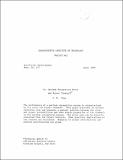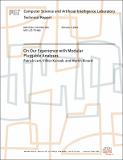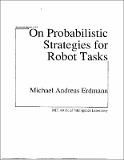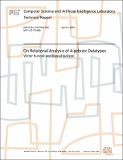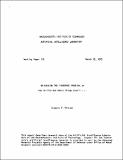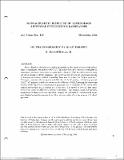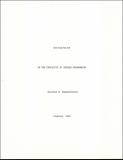Browsing Computer Science and Artificial Intelligence Lab (CSAIL) by Title
Now showing items 2302-2321 of 3804
-
On Multiple Moving Objects
(1986-05-01)This paper explores the motion planning problem for multiple moving objects. The approach taken consists of assigning priorities to the objects, then planning motions one object at a time. For each moving object, the ... -
On Optimum Recognition Error and Reject Tradeoff
(1969-04-01)The performance of a pattern recognition system is characterized by its error and reject tradeoff. This paper describes an optimum rejection rule and presents a general relation between the error and reject probabilities ... -
On Our Experience with Modular Pluggable Analyses
(2004-10-04)We present a technique that enables the focused applicationof multiple analyses to di erent modules in thesame program. In our approach, each module encapsulatesone or more data structures and uses membershipin abstract ... -
On Playing Well in a Sum of Games
(1985-08)Many games are naturally described as a sum of games, e.g., nim and the endgame of Go. Let G ,...,G represent n games. Then a move in the sum G + ...+G consists of picking a component game G and making a move in G ... -
On Probabilistic Strategies for Robot Tasks
(1989-08-01)Robots must act purposefully and successfully in an uncertain world. Sensory information is inaccurate or noisy, actions may have a range of effects, and the robot's environment is only partially and imprecisely ... -
On Randomized Path Coverage of Configuration Spaces
(2013-11-18)We present a sampling-based algorithm that generates a set of locally-optimal paths that differ in visibility. -
On Reducibility Among Combinatorial Problems
(1973-12)A large class of combinatorial problems have been shown by Cook and Karp to be computationally equivalent to within a polynomial. We exhibit some new problems in this class, and provide simpler proofs for some of the known ... -
On Relational Analysis of Algebraic Datatypes
(2005-04-05)We present a technique that enables the use of finite modelfinding to check the satisfiability of certain formulaswhose intended models are infinite. Such formulas arisewhen using the language of sets and relations to ... -
On Retiming Synchronous Circuitry and Mixed-integer Optimization
(1990-09)In this paper we investigate properties of retiming, a circuit transformation which preserves the behavior of the circuit as a whole. We present an algorithm which transforms a given combinational circuit into a functionally ... -
On Role Logic
(2003-10-24)We present role logic, a notation for describing propertiesof relational structures in shape analysis, databases, andknowledge bases. We construct role logic using the ideas ofde Bruijn's notation for lambda calculus, an ... -
On Solving The Findspace Problem, or How to Find Out Where Things Aren't ....
(MIT Artificial Intelligence Laboratory, 1973-03-29) -
On Spatial Conjunction as Second-Order Logic
(2004-10-25)Spatial conjunction is a powerful construct for reasoning about dynamically allocateddata structures, as well as concurrent, distributed and mobile computation. Whileresearchers have identified many uses of spatial ... -
On the Adaptive Real-Time Detection of Fast-Propagating Network Worms
(2006-11-10)We present two light-weight worm detection algorithms thatoffer significant advantages over fixed-threshold methods.The first algorithm, RBS (rate-based sequential hypothesis testing)aims at the large class of worms that ... -
On The Boolean Algebra of Shape Analysis Constraints
(2003-08-22)Shape analysis is a promising technique for statically verifyingand extracting properties of programs that manipulatecomplex data structures. We introduce a new characterizationof constraints that arise in parametric ... -
On the Complexity of Computing Algebraic Functions
(1990-09)This research addresses the problem of proving lower bounds on the complexity of algebraic computations involving the floor operation. The model of computation considered is a computation tree with the set of basic ... -
On the Complexity of ID/LP Parsing
(1984-12-01)Recent linguistic theories cast surface complexity as the result of interacting subsystems of constraints. For instance, the ID/LP grammar formalism separates constraints on immediate dominance from those on linear ... -
On the Complexity of Integer Programming
(1980-02)We give a simple proof that integer programming is in NP. Our proof also establishes that there is a pseudopolynomial time algorithm for integer programming with any (fixed) number of constraints. -
On the Complexity of the Theories of Weak Direct Products
(1974-01)Let N be the set of nonnegative integers and let < N ,+> be the weak direct product of < N,+> with itself. Mostowski[ 9 ] shows that the theory of < N ,*> is decidable, but his decision procedure isn't elementary recursive. ... -
On the Computational Complexity of Cardinality Constraints in Relational Databases
(1980-03)We show that the problem of determining whether of not a lossless join property holds for a database, in the presence of key dependencies and cardinality constraints on the domains of the attributes is NP-complete. -
On the Convergence of Stochastic Iterative Dynamic Programming Algorithms
(1993-08-01)Recent developments in the area of reinforcement learning have yielded a number of new algorithms for the prediction and control of Markovian environments. These algorithms, including the TD(lambda) algorithm of Sutton ...


